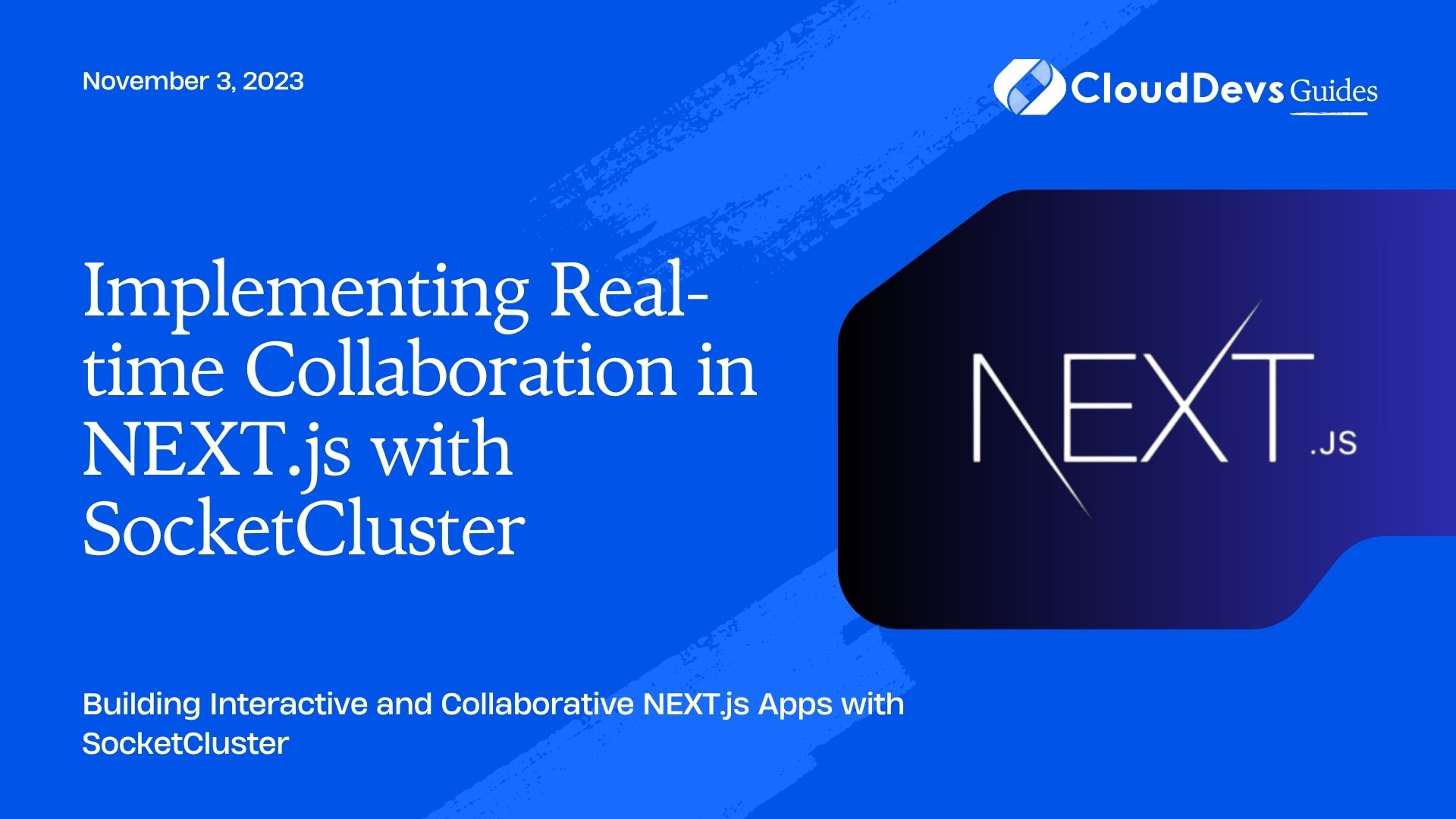Implementing Real-time Collaboration in NEXT.js with SocketCluster
In today’s fast-paced digital world, real-time collaboration has become a necessity for many web applications. Whether you’re building a chat application, a collaborative document editor, or a live dashboard, enabling real-time updates and interactions is crucial for providing a seamless user experience. In this blog post, we will explore how to implement real-time collaboration in a NEXT.js application using SocketCluster.
1. What is SocketCluster?
SocketCluster is a real-time, highly scalable, and framework-agnostic WebSocket framework that simplifies the process of adding real-time capabilities to your web applications. It’s built on top of WebSocket technology, providing a simple and efficient way to handle bidirectional communication between clients and servers.
SocketCluster offers a range of features that make it an excellent choice for building real-time applications:
- Scalability: SocketCluster can be easily scaled horizontally, allowing your application to handle a large number of concurrent connections.
- Authentication: It provides built-in authentication mechanisms to secure your real-time channels and events.
- Pub-Sub: SocketCluster supports publish-subscribe patterns, making it easy to broadcast messages to multiple clients.
- Middleware: You can add custom middleware to handle various aspects of the communication process.
- Automatic Reconnection: It automatically handles client reconnections, ensuring a reliable connection even in unreliable network conditions.
- Flexibility: SocketCluster can be used with various front-end and back-end technologies, making it a versatile choice for different types of applications.
Now that we have a brief overview of SocketCluster, let’s dive into the implementation of real-time collaboration in a NEXT.js application using this powerful framework.
2. Prerequisites
Before we start implementing real-time collaboration, make sure you have the following prerequisites in place:
- Node.js: Ensure that you have Node.js installed on your development machine. You can download it from the official website.
- NEXT.js: If you haven’t already set up a NEXT.js project, you can do so by following the official documentation.
- SocketCluster: You can add SocketCluster to your project by running the following command:
bash npm install socketcluster-server socketcluster-client
With the prerequisites in place, let’s move on to the implementation steps.
Step 1: Setting Up SocketCluster Server
First, we need to create a SocketCluster server that will handle real-time communication between clients. Create a new file named server.js in your NEXT.js project directory and add the following code:
javascript
// server.js
const socketCluster = require('socketcluster-server');
const http = require('http');
const httpServer = http.createServer();
const agServer = socketCluster.attach(httpServer);
httpServer.listen(8000, () => {
console.log('SocketCluster server is listening on port 8000');
});
agServer.on('connection', (socket) => {
console.log(`Client ${socket.id} connected`);
// Handle disconnect event
socket.on('disconnect', () => {
console.log(`Client ${socket.id} disconnected`);
});
});
// Add your real-time event handlers here
In this code:
- We import the necessary modules, create an HTTP server, and attach SocketCluster to it.
- The server listens on port 8000 for incoming WebSocket connections.
- We handle the connection event to log when clients connect and disconnect.
Now that the server is set up, you can start it using the following command:
bash node server.js
Your SocketCluster server is now running and ready to handle real-time connections.
Step 2: Adding Real-time Collaboration to Your NEXT.js App
With the SocketCluster server in place, let’s integrate real-time collaboration into your NEXT.js application.
2.1. Client-Side Setup
In your NEXT.js application, create a new JavaScript file (e.g., realtime.js) to manage the client-side SocketCluster connection. Here’s how you can set it up:
javascript
// realtime.js
import { create } from 'socketcluster-client';
const socket = create({ hostname: 'localhost', port: 8000 });
socket.on('connect', () => {
console.log('Connected to real-time server');
});
socket.on('disconnect', () => {
console.log('Disconnected from real-time server');
});
export default socket;
In this code:
- We import the create function from socketcluster-client to create a WebSocket connection to the SocketCluster server.
- We specify the hostname and port of the server to connect to. Adjust these values as needed to match your server configuration.
- We listen for the connect and disconnect events to log when the client connects and disconnects from the real-time server.
2.2. Implementing Real-time Collaboration Features
Now that we have our SocketCluster client set up, we can implement real-time collaboration features in our NEXT.js app. Here are a few examples:
Real-time Chat
javascript
// chat.js
import React, { useEffect, useState } from 'react';
import socket from './realtime';
function Chat() {
const [messages, setMessages] = useState([]);
const [newMessage, setNewMessage] = useState('');
useEffect(() => {
// Subscribe to a chat channel
const chatChannel = socket.subscribe('chat');
// Listen for incoming messages
chatChannel.watch((message) => {
setMessages((prevMessages) => [...prevMessages, message]);
});
return () => {
// Unsubscribe when component unmounts
chatChannel.unsubscribe();
};
}, []);
const handleSendMessage = () => {
if (newMessage.trim() !== '') {
socket.transmit('chat', { text: newMessage });
setNewMessage('');
}
};
return (
<div>
<div className="chat">
{messages.map((message, index) => (
<div key={index} className="message">
{message.text}
</div>
))}
</div>
<div className="input">
<input
type="text"
placeholder="Type your message..."
value={newMessage}
onChange={(e) => setNewMessage(e.target.value)}
/>
<button onClick={handleSendMessage}>Send</button>
</div>
</div>
);
}
export default Chat;
In this example, we create a simple chat component that subscribes to a “chat” channel and displays incoming messages in real time.
Real-time Collaboration on Documents
javascript
// document.js
import React, { useEffect, useState } from 'react';
import socket from './realtime';
function Document() {
const [content, setContent] = useState('');
useEffect(() => {
// Subscribe to a document channel
const docChannel = socket.subscribe('document');
// Listen for changes to the document content
docChannel.watch((newContent) => {
setContent(newContent);
});
return () => {
// Unsubscribe when component unmounts
docChannel.unsubscribe();
};
}, []);
const handleContentChange = (e) => {
const newContent = e.target.value;
socket.transmit('document', newContent);
setContent(newContent);
};
return (
<div>
<textarea
value={content}
onChange={handleContentChange}
placeholder="Start collaborating..."
/>
</div>
);
}
export default Document;
In this example, we create a component that allows real-time collaboration on a document. Users can edit the document content, and changes are synchronized in real time.
Step 3: Testing Your Real-time Collaboration Features
With the real-time collaboration features implemented, it’s time to test your application. Start your NEXT.js development server using the following command:
bash npm run dev
Open your application in multiple browser tabs or devices to simulate multiple users. You should see real-time updates for chat messages or document content as users interact with the application.
Conclusion
In this blog post, we’ve learned how to implement real-time collaboration in a NEXT.js application using SocketCluster. We started by setting up a SocketCluster server to handle real-time communication and then integrated real-time chat and document collaboration features into our application. With the power of SocketCluster, you can now build interactive and collaborative web applications that provide a seamless user experience.
Real-time collaboration is just one of the many possibilities with SocketCluster. You can explore additional features such as authentication, presence channels, and custom middleware to tailor your real-time application to your specific needs. Happy coding!
Table of Contents









